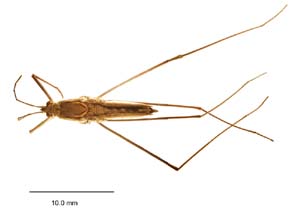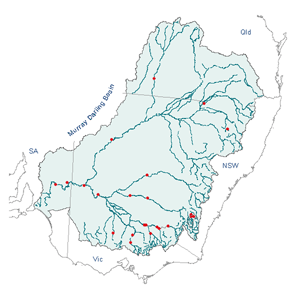Taxon Attribute Profiles

Aquarius antigone female
|
Aquarius antigone (Kirkaldy)
Water strider, pond skater
Introduction
Water striders or pond skaters are fascinating creatures which seem to
glide over the surface of the water. The pressure of a leg produces a
trough shaped depression (meniscus) on the water surface film, and the
surface tension of the water easily supports the weight of the insect.
Locomotion can be achieved through processes of walking, rowing, and skating,
and they can move quite quickly to catch prey or escape predation. Pond
skaters are predatory, and sense their prey by detecting surface ripples.
Taxonomy and Ecology
Classification
Order Hemiptera
Infraorder Gerromorpha
Family Gerridae
Life Form
Water striders are quite easy to recognize, and there is nothing
that they could be confused with. They are elongate, with long legs, and
they skate across the surface of relatively still water. Their middle
and hind legs are at least 3 times as long as their fore legs. There are
several groups of water striders, but within the Murray Darling Basin
there is only the genus Aquarius that reaches the size of 10-14
mm in body length (longer including the legs). Further characteristics
and diagnostic characters are given by Andersen & Weir (2004).
There are two species of Aquarius in Australia, but only A.
antigone enters the Murray Darling Basin. Four other species of water
striders, occur in the Murray Darling Basin: Tenagogerris euphrosyne,
Rheumatometra dimorpha, R. pilarete, Rhagadotarsus anomalus. They
can all be recognized from A. antigone by their smaller size (all
less than 10mm).

Click to enlarge map
|
Distribution
Aquarius antigone is found in the coastal areas of Queensland,
large parts of New South Wales, ACT, Victoria, and eastern South Australia
(Andersen & Weir, 2004).
Habitat
Water striders occur in large to small groups on the surface of still
water (ponds, lakes) and near the calm edges of flowing water (rivers,
streams). Adults and nymphs both inhabit the same types of areas, and
they tend to avoid fast running water. Their ability to skate on the surface
comes from their tarsi (terminal leg segments) being clothed in fine hairs
which prevent the tarsi from getting wet.
Status in Community
Both adults and nymphs are predaceous. As prey items are generally
insects that fall onto the surface of the water, it may mean that A.
antigone may not have the same effect in controlling population levels
of their prey as some other predators, because they may be differentially
preying on old and/or weak individuals.
Reproduction and Establishment
Reproduction
Ripples on the water surface are important signals, and can be used for
tracking prey, as well as for communication within the species. In some
species of water striders, ripples are used for attracting mates; in others
males use them to defend their territory.
Dispersability
Winged adults are rare in A. antigone, and one can expect very
limited dispersal between drainage systems. Thus, this species will be
more at risk due to local disturbances and changes in water regimes because
there is a low chance of recolonization from neighbouring regions.
Juvenile period
Eggs are laid either on floating debris, or sometimes underwater.
The nymphal stages do not differ significantly in morphology from the
adult stages. All stages are predatory, and they pierce their prey with
elongate beaks which they use to suck out the bodily fluids.
Hydrology and Salinity
Salinity Tolerance
Data concerning the sensitivity of Aquarius species to increased
salinity levels of other forms of environmental changes is not available.
In general, Gerridae have been seen to be moderately tolerant to salinity
levels (Gooderham & Tsyrlin, 2002; Chessman, 2003).
Flooding Regimes
Because A. antigone rarely produces winged adults, its ability
to respond to periods of flooding and drought is diminished, and its chances
for survival in areas which are intermittently riparian is reduced.
Conservation Status
Goonan et al. (2004) listed this species as rare for the Murray
River. It is actually quite common and widespread throughout eastern Australia;
however, it reaches the southernmost ranges of its distribution in the
Murray Darling Basin (Andersen & Weir, 2004). For this reason, it
might be locally rare, and more susceptible to environmental changes.
In other parts of the world Aquarius species have been shown
to be susceptible to environmental change. In Europe, A. najas
appears to be threatened due to a reduction in suitable habitats; and
A. paludum has increased its population levels conspicuously in
response to the creation of ponds stocked for angling (Nieser & Wascher,
1986; Damgaard & Andersen, 1996; Andersen & Weir, 2004). The effects
on other macroinvertebrates from the increased populations of A. paludum
have not been quantified.
Summary
A. antigone shares the characteristics of macroinvertebrates
that could make them suitable species for including in programs for monitoring
water quality (Water and Rivers Commission, 1996; Chessman, 2003; Minnesota
Pollution Control Agency, 2004), and European species of Aquarius
have shown that they respond to environmental disturbance and changes
in water regimes. These factors, coupled with the fact that A. antigone
can be easily recognized by non-specialists, and can be seen on the surface
of the water, makes them an attractive element for a program of monitoring
macroinvertebrates.
References
Andersen, N.M. & Weir, T.A. (2004) Australian Water Bugs: Their
Biology and Identification. Entomonograph Volume 14. Apollo Books.
Chessman, B. (2003) SIGNAL 2 - A Scoring System for Macroinvertebrate
('Water Bugs') in Australian Rivers, Monitoring River Heath Initiative
Technical Report no 31, Commonwealth of Australia, Canberra.
http://www.deh.gov.au/water/rivers/nrhp/signal/
Damgaard, J., & Andersen, N.M. (1996) Distribution, phenology,
and conservation status of the larger water striders in Denmark. Entomologiske
Meddelelser 64: 289-306.
Gooderham, J. & Tsyrlin, E. (2002) The Waterbug Book: a guide to
the freshwater macroinvertebrates of temperate Australia. CSIRO Publishing.
Goonan, P., Madden, C., McEvoy, P., Taylor, D. & Gray, B. (2004)
River Health in the River Murray Catchment. Department for Environment
and Heritage, Government of South Australia. http://www.environment.sa.gov.au/epa/pdfs/river_health_murray.pdf
Minnesota Pollution Control Agency (2004). Wetlands: Monitoring Aquatic
Invertebrates. http://www.pca.state.mn.us/water/biomonitoring/bio-wetlands-invert.html
Nieser, N. & Wasscher, M. (1986) The status of the larger waterstriders
in the Netherlands (Heteroptera: Gerridae). Entomologische Berichten
(Amsterdam), 46: 68-76.
Water and Rivers Commission (1996). Macroinvertebrates & Water
Quality. Water Facts 2. http://www.wrc.wa.gov.au/public/waterfacts/2_macro/WF2.pdf
|

